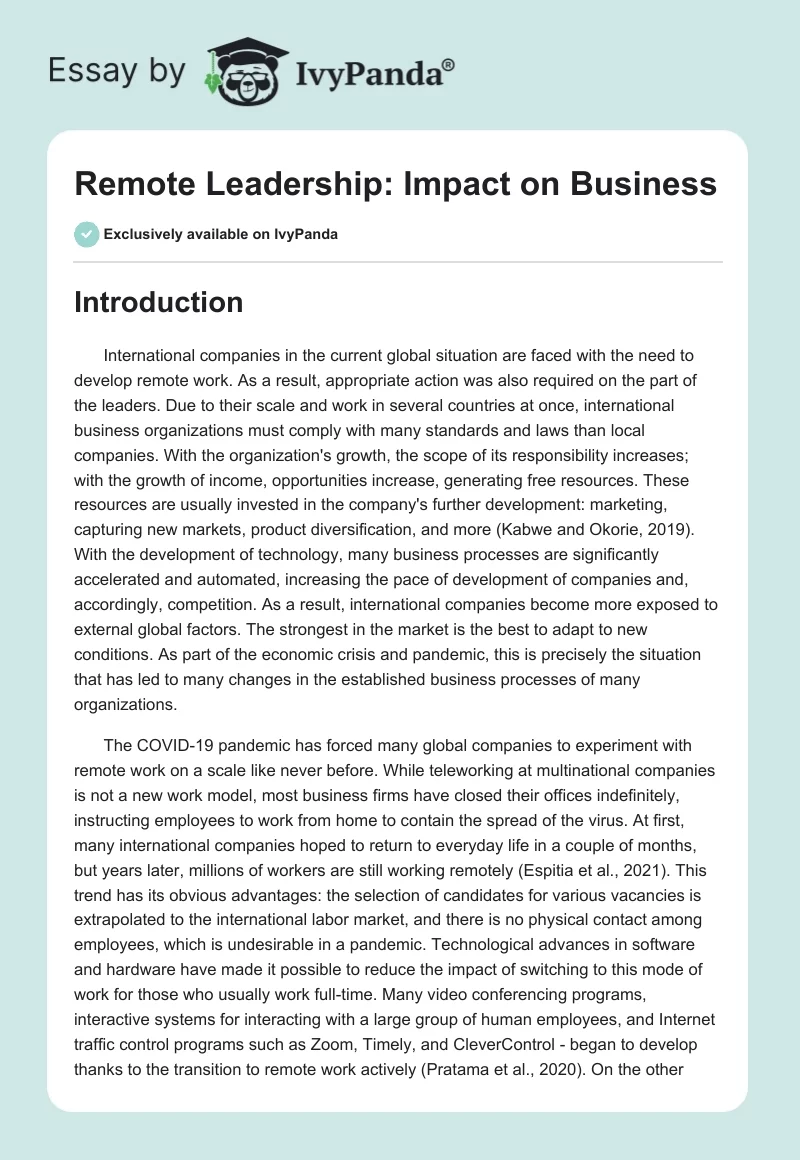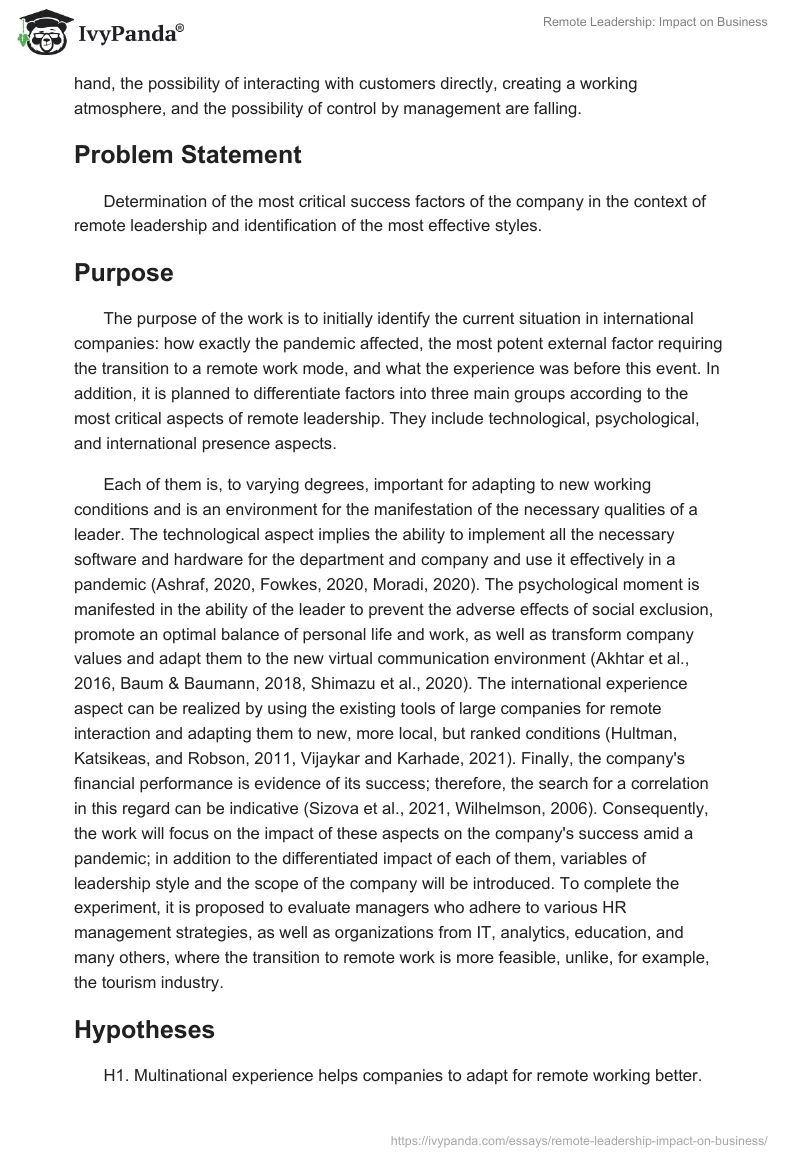Introduction
International companies in the current global situation are faced with the need to develop remote work. As a result, appropriate action was also required on the part of the leaders. Due to their scale and work in several countries at once, international business organizations must comply with many standards and laws than local companies. With the organization’s growth, the scope of its responsibility increases; with the growth of income, opportunities increase, generating free resources. These resources are usually invested in the company’s further development: marketing, capturing new markets, product diversification, and more (Kabwe and Okorie, 2019). With the development of technology, many business processes are significantly accelerated and automated, increasing the pace of development of companies and, accordingly, competition. As a result, international companies become more exposed to external global factors. The strongest in the market is the best to adapt to new conditions. As part of the economic crisis and pandemic, this is precisely the situation that has led to many changes in the established business processes of many organizations.
The COVID-19 pandemic has forced many global companies to experiment with remote work on a scale like never before. While teleworking at multinational companies is not a new work model, most business firms have closed their offices indefinitely, instructing employees to work from home to contain the spread of the virus. At first, many international companies hoped to return to everyday life in a couple of months, but years later, millions of workers are still working remotely (Espitia et al., 2021). This trend has its obvious advantages: the selection of candidates for various vacancies is extrapolated to the international labor market, and there is no physical contact among employees, which is undesirable in a pandemic. Technological advances in software and hardware have made it possible to reduce the impact of switching to this mode of work for those who usually work full-time. Many video conferencing programs, interactive systems for interacting with a large group of human employees, and Internet traffic control programs such as Zoom, Timely, and CleverControl – began to develop thanks to the transition to remote work actively (Pratama et al., 2020). On the other hand, the possibility of interacting with customers directly, creating a working atmosphere, and the possibility of control by management are falling.
Problem Statement
Determination of the most critical success factors of the company in the context of remote leadership and identification of the most effective styles.
Purpose
The purpose of the work is to initially identify the current situation in international companies: how exactly the pandemic affected, the most potent external factor requiring the transition to a remote work mode, and what the experience was before this event. In addition, it is planned to differentiate factors into three main groups according to the most critical aspects of remote leadership. They include technological, psychological, and international presence aspects.
Each of them is, to varying degrees, important for adapting to new working conditions and is an environment for the manifestation of the necessary qualities of a leader. The technological aspect implies the ability to implement all the necessary software and hardware for the department and company and use it effectively in a pandemic (Ashraf, 2020, Fowkes, 2020, Moradi, 2020). The psychological moment is manifested in the ability of the leader to prevent the adverse effects of social exclusion, promote an optimal balance of personal life and work, as well as transform company values and adapt them to the new virtual communication environment (Akhtar et al., 2016, Baum & Baumann, 2018, Shimazu et al., 2020). The international experience aspect can be realized by using the existing tools of large companies for remote interaction and adapting them to new, more local, but ranked conditions (Hultman, Katsikeas, and Robson, 2011, Vijaykar and Karhade, 2021). Finally, the company’s financial performance is evidence of its success; therefore, the search for a correlation in this regard can be indicative (Sizova et al., 2021, Wilhelmson, 2006). Consequently, the work will focus on the impact of these aspects on the company’s success amid a pandemic; in addition to the differentiated impact of each of them, variables of leadership style and the scope of the company will be introduced. To complete the experiment, it is proposed to evaluate managers who adhere to various HR management strategies, as well as organizations from IT, analytics, education, and many others, where the transition to remote work is more feasible, unlike, for example, the tourism industry.
Hypotheses
H1. Multinational experience helps companies to adapt for remote working better.
H2. A remote leader has a positive effect on the mental state of employees and the atmosphere in the team.
H3. Technical equipment or lack of it affects the efficiency of remote workers.
H4. Remote leadership affects the company’s financial performance.
Conclusion
This paper proposes to evaluate various factors influencing remote leadership strategies and determine the most effective styles and aspects of the new interaction environment. This goal can be achieved through quantitative research using questionnaires and evaluation of financial statements of companies selected from various areas and searching for correlations using a t-test. As an idea of a theoretical framework, it is possible to adapt the classification of these aspects to the Homans model or the theory of group behavior.
Reference List
Akhtar, P., et al. (2016) ‘Data-driven and adaptive leadership contributing to sustainability: Global agri-food supply chains connected with emerging markets’, International Journal of Production Economics, 181, pp. 392-401. Web.
Ashraf, B. N. (2020) ‘Economic impact of government interventions during the COVID-19 pandemic: International evidence from financial markets’, Journal of Behavioral and Experimental Finance, 27, p. 100371. Web.
Baum, I. R., and Baumann, N. (2018) ‘Autonomous creativity: The implicit autonomy motive fosters creative production and innovative behavior at school’, Gifted and Talented International, 33(1-2), pp. 15-25. Web.
Espitia, A., et al. (2021) ‘Pandemic trade: COVID‐19, remote work and global value chains’, The World Economy, 45(2), pp. 561-589. Web.
Fowkes, L. (2020) ‘Seeing people in the computer: the role of information technology in remote employment services’, Australian Journal of Social Issues, 55(1), pp. 13-26. Web.
Hultman, M., Katsikeas, C. S., and Robson, M. J. (2011) ‘Export promotion strategy and performance: The role of international experience’, Journal of International Marketing, 19(4), pp. 17-39. Web.
Moradi, S., et al. (2020) ‘Comparison of research and industry views on project managers’ competencies’, International Journal of Managing Projects in Business, 13(3), pp. 543-572. Web.
Pratama, H., et al. (2020) ‘The Trend in using online meeting applications for learning during the period of pandemic COVID-19: A literature review’, Journal of Innovation in Educational and Cultural Research, 1(2), pp. 58-68. Web.
Shimazu, A., et al. (2020) ‘Psychosocial impact of COVID-19 for general workers’, Journal of Occupational Health, 62(1), p. e12132. Web.
Sizova, I., et al. (2021, June) ‘Labor Demand and Supply Adaptation to the Pandemic-Induced Shock’ in International Conference on Digital Transformation and Global Society (pp. 461-476). London, UK: Springer, Cham. Web.
Vijaykar, S., and Karhade, P. (2021) ‘Remote Virtual Workplaces in the Pandemic: The Case of IT-enabled Service Leadership’ in Pacific Asia Conference on Information Systems. Web.
Wilhelmson, L. (2006) ‘Transformative learning in joint leadership’, Journal of Workplace Learning, 18(7/8), pp. 495-507. Web.


